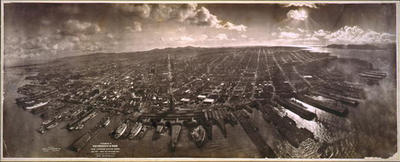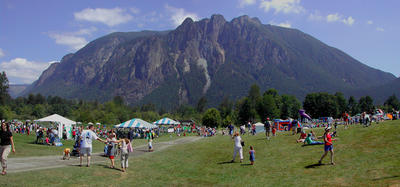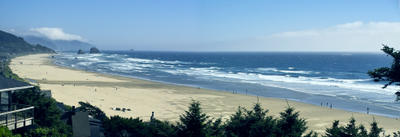
4 SD10 photos stitched with PanoTools
No, this isn't a post about playing the piano. Instead, I want to talk a little about panoramic photographs, aka 'panoramas' or photos that are much larger in one dimension than the other.
 Panoramas can be vertical (portrait) or horizontal (landscape) in orientation. The earliest panoramas that I'm familiar with were landscapes and were usually sections of conventional photographs that were cropped to give the panoramic format. However, panoramic cameras have existed since the late 1800s; I have one early panorama that was taken in 1917 with a Circut camera (a marriage of a complicated clockworks to a camera that produced some very fine panoramas) at a US Army training camp showing a company of men getting ready to head for France; I'm sure that such photos were popular with the Army itself which commissioned the photos as well as the men in the photos.
Panoramas can be vertical (portrait) or horizontal (landscape) in orientation. The earliest panoramas that I'm familiar with were landscapes and were usually sections of conventional photographs that were cropped to give the panoramic format. However, panoramic cameras have existed since the late 1800s; I have one early panorama that was taken in 1917 with a Circut camera (a marriage of a complicated clockworks to a camera that produced some very fine panoramas) at a US Army training camp showing a company of men getting ready to head for France; I'm sure that such photos were popular with the Army itself which commissioned the photos as well as the men in the photos. The earliest panoramas were created by manually 'stitching' several individual photographs together at the seams. This required dexterity in the darkrooms of the day, and while the results weren't perfect (seams, or differences in exposures, were often visible in the finished panoramas) the pictures were often fascinating. Panoramas were initially created to overcome the lens limitations of early photography; often only one focal length with a correspondingly narrow field of view was available to the photographer. However, panoramas have a beauty and appeal all their own and soon a few photographers started specializing in this form.

from Lawrence Captive Airship, 2000 feet above San Francisco Bay
1906 Geo. R. Lawrence Co. (from the Library of Congress)
Special cameras dedicated to panoramic photos have been designed and sold for decades, but have not sold well to the general public. Even though these cameras use standard-sized film, the negative format was different and unsuitable for commercial processing; the processor often inadvertantly sliced the panoramic negative assuming the film was separated into standard-sized negatives. During the 1970s, and again in the 1990s, Kodak designed and built consumer cameras with panoramic features in both 110 and APS formats, but these cameras were not generally adopted due to their small negative size and fixed lens design. The expense and complexity of taking panoramas with high-end specialized cameras, and the difficulty of splicing pictures from regular cameras, have kept panoramas out of the province of all but the most dedicated amateur and professional photographers, until now.

two Nikon 885 photos stitched via Arcsoft Panorama Maker 2000
Digital cameras have revolutionized panoramic photography (along with everything else in the photographic world). Most digital cameras today come with a plethora of accessory software and often panoramic software is included at no charge. These programs let you assemble panoramas from several overlapping photographs and do a remarkably fine job with little or no user input. The picture above, "Mount Si", was made from two separate photos that overlapped by about 20% on the adjacent sides, using Arcsoft's Panorama Maker 2000 software supplied with my Nikon Coolpix 885 camera. Using the panoramic format allowed me to capture a scene that otherwise could not be photographed with my camera; even on it's widest 8mm focal length (equivalent to a 35mm lens on a 35mm camera) I could only include about half of the mountain.
Capturing scenes like that, or like the shot of Cannon Beach that I posted a week ago, would be impossible with normal cameras. Yes, you might be able to get the same effective field of view with a super-wide-angle lens, but you would lose the detail that exists in the original (the photo that you see above is about 1/8th actual size, the enlarged version you get upon clicking on it is 1/2 actual size). And that leads me to another reason for taking panoramas; I can capture much more detail that I could if I used the appropriate wide-angle lens and just took one photograph. The photo "C5 #2" below is a reduced example of a photo that, at full size, has the horizontal resolution of a 25 megapixel camera. It will look impressive hanging on the wall.

all rights reserved
4 SD10 photos stitched with PanoTools
Max Lyons was the first non-governmental photographer to create a one-gigapixel digital image (yes, one billion pixels!) (The US government has gigapixel-equivalent camera capabilities for photoreconnaissance.) The race is on: a group of scientists from the Netherlands has created a 2.5 gigapixel image on a bet inspired by discussion of Lyons' photograph. What Lyons and other photographers are doing is stretching the limits of resolution to places where film cannot compete. It is generally accepted that 6- to 8-megapixel APS-sensor digital cameras (not smaller 1/1.8" sensor digicams) have image quality equal to 35mm 100 ASA color film, and medium format imagery is roughly equivalent to a 24 megapixel image.
Imagine then, a film camera that could take a 1-gigapixel image... and you would see the Gigapixl camera, a very large-format negative film camera that digitizes the negative and prints the resultant image on high resolution inkjet printers. At this moment, large format film has one advantage over digital: it is currently impossible to make a 1-gigapixel digital sensor. However, as digital technology advances, expect to see the average consumer digicam producing prints better than the best 35mm cameras of a generation ago... and expect to see digital SLRs produce prints as good or better than the best of today's medium format equipment.
Those who decried digital photography as the end of photography were wrong. It is only the beginning.
Note: You can view a larger version of any photo on my website by clicking on the image. All images, unless otherwise noted, are copyright 2005 John Clifford and all rights are reserved. Please do not copy them without permission.


